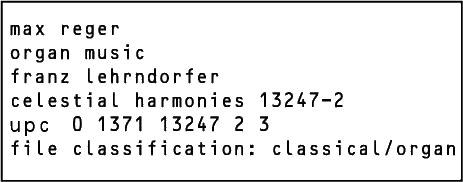 |
||||||||||||||||||||||||||||||||||||||||||||||||
 
BADISCHE ZEITUNG, May 2006 (.pdf)
the project“Have we completely forgotten that the organ is a first class instrument, not just something for churches?” This lament of Max Reger (1873-1916), quoted in a letter, was directed at the ignorance of contemporaries, to whom virtuosity in organ music, even in the works of Johann Sebastian Bach, was suspect. Reger, however, possessed a wide knowledge of both baroque and romantic organ music, and was not dismayed by his critics. The best known of Reger’s organ works—published without opus number—is the 'Introduction and Passacaglia' in D Minor, the opening track on this new recording by Franz Lehrndorfer. The ‘Toccata and Fugue’ in A Minor concluding the collection of ‘Twelve Organ Works’ Op. 80, places no fewer demands on the player than the previous track, which Reger described as “not too difficult”. The ‘Twelve Organ Pieces’ Op. 59 are as suited for a church as for the concert hall. Although intended to be technically accessible to a wide range of organists, they are more difficult than they seem on paper, if one is to realize Reger’s intentions convincingly. A suitable organ must allow subtle dynamic gradations, and judicious use of swell pedal and Walze is essential for the very precise tonal and dynamic indications. Although unproblematic for an orchestra, these details require much more concentration from the organist than just the notes alone. Lehrndorfer writes “The ‘Benedictus’ is a triumph of musical rhetoric. Deeply religious, it moves from mystical colourings to ecstatic jubilation, and from the celebratory hosanna back to seraphic adulation.” Above all, the ‘Fantasy and Fugue on B-A-C-H’ is full of infectious inspiration, achieving Reger’s aim: “This must be a work of the grandest style, I will try my utmost.” The success of Reger’s efforts can be judged by the popularity of the piece as well as by its characterisation as a “timeless summit of organ music” (Fritz Stein). If the admittedly somewhat inaccessible organ music of Reger is increasingly regaining its deserved status in Germany, Europe and even the USA and Japan, then this is to a large degree the achievement of Franz Lehrndorfer: both as an outstanding performer of this music, and as an inspiring pedadogue, who has generated a whole generation of Reger enthusiasts. the artistFranz Lehrndorfer was born in 1928 in Salzburg, Austria, of German parents. He grew up in Kempten, Bavaria, and received his early musical education from his father, a choir conductor and musicologist. He begun his professional life in 1951 as an educator with the German boys choir Regensburger Domspatzen, where he met his future producer/engineer Ulrich Kraus, who was one of the choir’s singers. Their friendship and collaboration has thus endured half a century. In 1957, he proved his mastery of the organ when he won first prize at the international ARD Competition sponsored by the German broadcasting network. In 1969 Lehrndorfer was appointed organist of the Munich Cathedral, the same year he became head of the Department of Organ and Catholic Liturgical Music at the Academy of Music in Munich. His renown and the resulting demand for his services as a teacher led him to found a School of Organ in Munich, which has since produced two generations of graduates. More than a few names well–known to the music world may be counted among them. Recently retired after more than 30 years as Dome Organist, Lehrndorfer has carried on a tradition of organ recitals initiated by his predecessors and has expanded their scope. Acclaimed contemporary composers write works for him to premiere. In Celestial Harmonies’ efforts to present Lehrndorfer’s
definitive catalogue, we also include a survey of the instruments
he has played over his illustrious career. The new organ in the
Dome at Munich is featured on Celestial Christmas 5 (13090-2),
The Concert (13109-2), Theme
& Variations, Vol. 2 (13209-2)
and John Stanley: Six Organ Concertos (13234-2),
the organ in the Pfarrkirche, St. Quirin, Tegernsee and the Dome
at Eichstätt on Bach Reger (14200-2),
the organ of St. Boniface in Munich on Romantic Organ Music
of the 19th Century (13213-2), and
the concert organ of the Academy of Music in Munich on Theme
& Variations, Vol. 1: Improvisations on Children’s Songs
(13208-2). biographydiscographytracklist
|
||||||||||||||||||||||||||||||||||||||||||||||||
|
|
||||||||||||||||||||||||||||||||||||||||||||||||
 |


